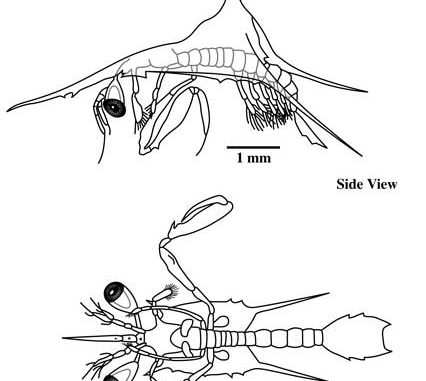
Trivia time. What looks like a shrimp, is as mean as a preying mantis and is eaten by red snappers like popcorn? Why, the mantis shrimp, of course. Mantis shrimp, primarily Squilla empusa, are among the most common bottom-living crustaceans in Gulf waters off Louisiana.
Mantis shrimp have a lot of local names. When I was a rookie biologist, I went on a shrimping trip with an old veteran shrimper and his crew out of Dulac. When the catch was emptied from a drag made right at sundown, one of the deckhands commented on all the “sea lights.”
I looked over the rail out into the night sea for something like the northern lights of the Arctic. This happened several times before I realized he was mispronouncing “sea lice,” a local misnomer for mantis shrimp.
Often also called “king shrimp” or “thumb-splitters,” they are the bane of shrimpers, although biologists think they are pretty cool. They are nocturnal, brainless and anti-social (like some people I know), and are voracious predators. They mate internally, and females carry their fertilized eggs beneath the front part of their bodies, before releasing the larvae to float in the sea’s currents.
Louisiana mantis shrimp live in burrows built in soft bottoms that have two or three openings. They defend their burrows vigorously against other mantis shrimp. Battles between males can be especially fierce. They attack each other with their powerful claws and deflect their opponent’s blows with their wide, flexible tails.
When not in use, their two powerful “raptorial claws” are kept folded beneath the fronts of their bodies, giving them their preying mantis-like appearance.
The world’s 400 mantis shrimp species can be divided into two groups based on the type of claws they possess.
“Smashers” have club-like claws they use to bludgeon their enemies and to break their meals apart. Smashers often eat hard-shelled creatures.
“Spearers” have knife-like raptorial claws that slash and spear through their prey. Our Squilla empusa is a spearer, which is how it got the moniker “thumb splitter.” One of the first things taught to a new shrimp boat deckhand is to beware of the serious and impressively bloody damage a mantis shrimp can do to an incautious finger.
The strike of a mantis shrimp’s raptorial claws is severe. It takes less than 8 milliseconds, which is 50 times faster than the blink of an eye. It doesn’t often miss, either.
Mantis shrimp have amazing eyes. They can see objects with three different parts of the eye, effectively giving each eye, separate of the other eye, trinocular vision and depth perception. They can and do move each eye on its stalk independently of the other, further giving it a preying mantis or alien-from-another-world look.
Squilla spends much of its time in its burrow, usually emerging at sunset. This is why shrimpers catch few of them until the trawl drag made right at sundown. Then, for one drag, they can catch bushels of them. Under dock lights at night, mantis shrimp can often be seen swimming sinuously and swiftly near the water’s surface.
They swim head forward and are propelled by the small swimming legs beneath their bodies. They are so incredibly flexible that they can turn back on themselves in their own body length. They can also use their wide tails to snap themselves backwards out of harm’s way, somewhat like a crawfish. More impressive is a twist jump, followed by a series of half-rolls, that removes the animal from the source of danger and leaves it facing the other way, set for a fast get-away.
Squilla empusa feeds on fish, shrimp, marine worms, snails, crabs and even other mantis shrimp. It can be a lurker, pouncing from ambush, but often voraciously hunts and relentlessly runs down its prey. Mantis shrimp have been observed to stalk their prey, similar to the way cats do.
As effective a predator as it is, other things love to eat Squilla themselves. Red snapper are major predators of the 8-inch creatures. Lots of fishermen assume red snapper haunt reefs because that’s where they make groceries. But nothing could be further from the truth.
Almost all the animals eaten by red snapper live on soft mud bottoms, including pipefish, snake eels, sea robins, pinfish, striped anchovies, cusk eels and mantis shrimp. The biggest snappers eat, by far, the most mantis shrimp. It seems that red snapper spend the daylight hours near reefs and structures, but make raids onto mud bottoms at night to feed.
Adult mantis shrimp are found in the stomachs of many other predacious fish species. Larval mantis shrimp, which drift as plankton, are also very important in the sea’s food web. Small fishes eat many of them, and some surprisingly large fish, like blackfin tuna, will strain the larvae from the water.
One link of the food chain they don’t fit in is mine. I am known as a person who will try to eat almost anything. But every time I have broken the head off the tail to inspect what’s inside, I see a gummy mess, and not a lot of that — nothing inviting to attract further culinary interest on my part.
Others do eat them. They are noted in McClane’s New Standard Fishing Encyclopedia as “extremely palatable” when boiled or fried. Some species are eaten by the Japanese on sushi rice and are called “shako.” Mantis shrimp are also consumed in China and various countries around the Mediterranean Sea.
Jerald Horst is an author of the Angler’s Guide to Fishes of the Gulf of Mexico, a 444-page, color-illustrated book on fishes written for saltwater fishermen. The book is available in better bookstores or can be ordered by calling 800-843-1724.


